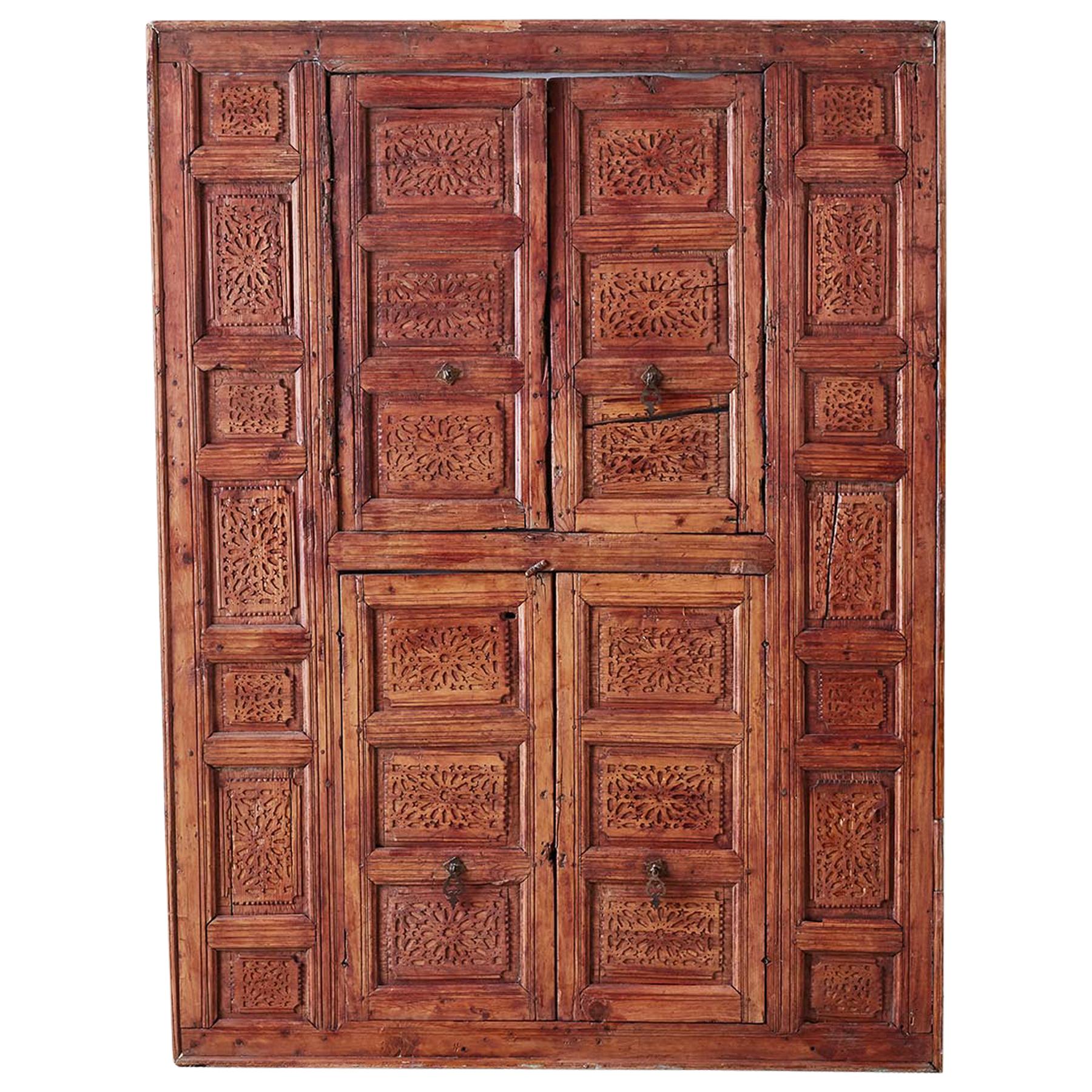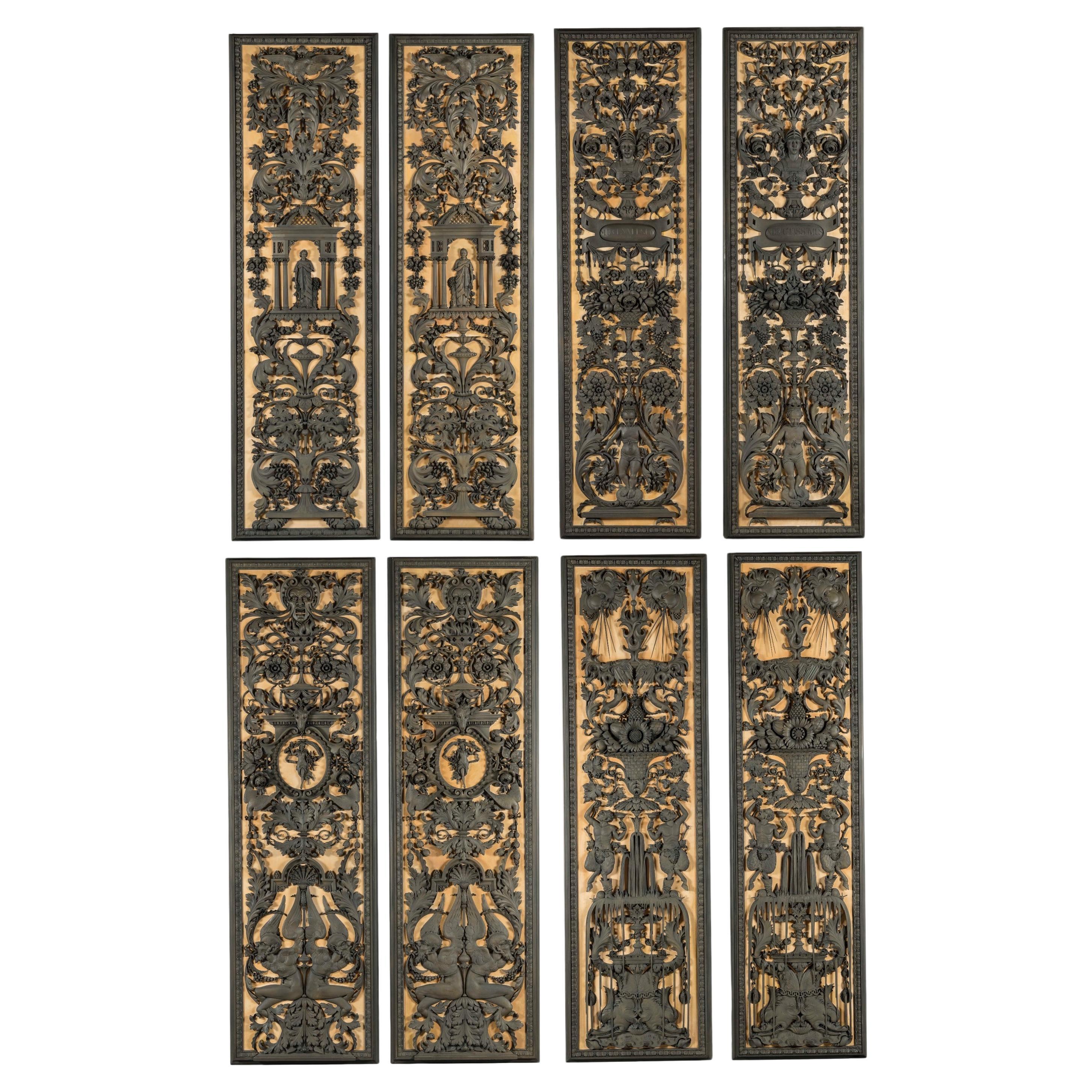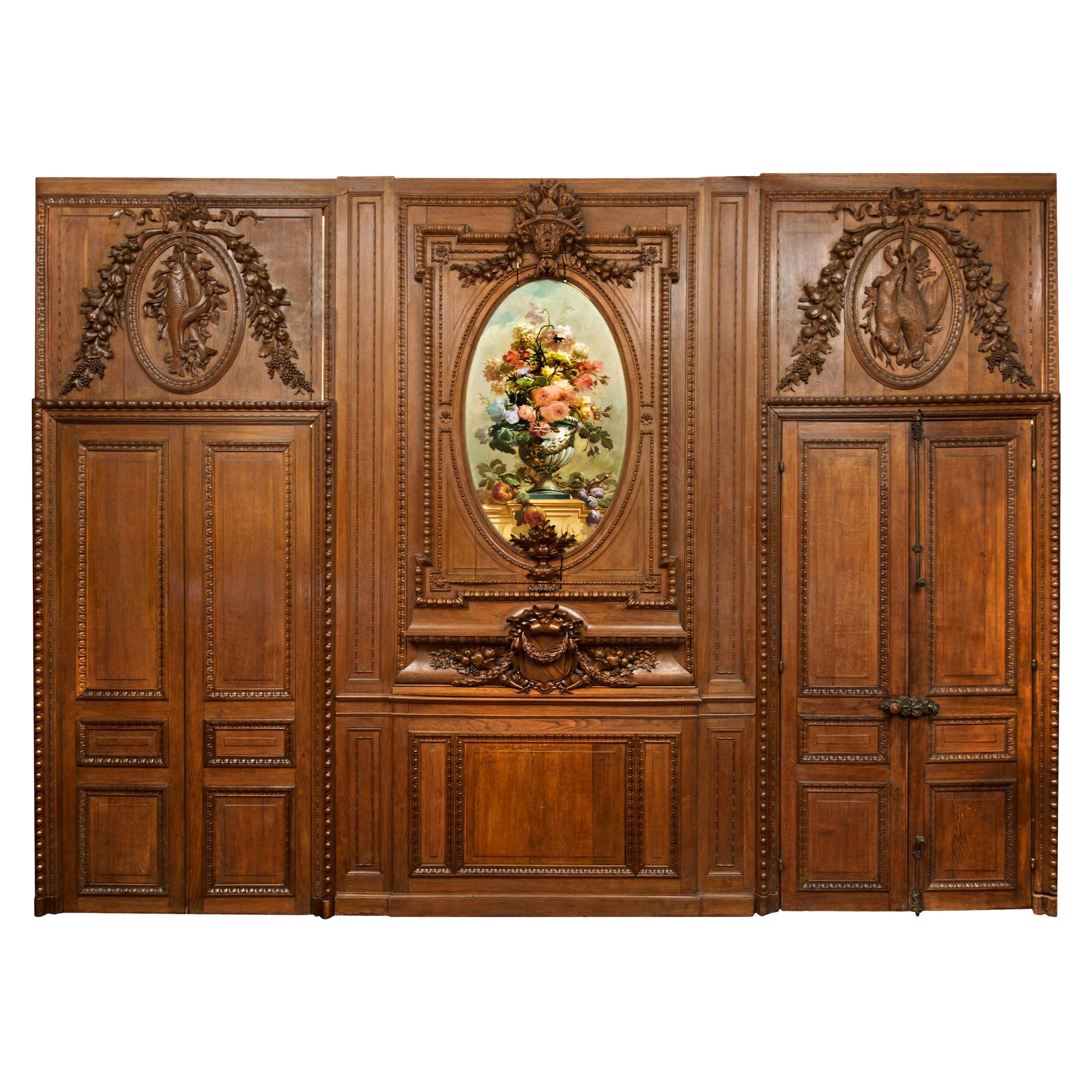Items Similar to 19th Century Moorish Revival Bronze Architectural Model Panel
Want more images or videos?
Request additional images or videos from the seller
1 of 11
19th Century Moorish Revival Bronze Architectural Model Panel
About the Item
A scarce antique Moorish architectural model thin bronze plaque from the late 19th century.
This architectural model features a symmetrical design, the bronze frame having three sections, each panel with large traditional Moorish architecture rounded horseshoe - keyhole arch, flanked by xa pair of smaller pierced arches, finely detailed, decorated in intricate relief work, with light arabesque motif, Islamic calligraphy inscriptions, two large Star of David hexagrams, and notched saw toothed edge ornamentation.
Provenance:
From the highly curated contents of well regarded professional antique dealers, Ed and Jane Grant, who retired after four decades in the industry. The couple supplied both their Washington metro based antique shop, Grant Antiques, and their very fine quality Connecticut showcase, E.J. Grant Antiques, with domestic and imported pieces. World travelers who especially loved European antiques, sourced their merchandise during their frequent buying trips to Europe and Asia and included purchases originating in France, the British Isles, Italy, Spain, and beyond.
"We have never been content with our established route. England is our first and favorite country and furniture. Then we discovered France. Then Holland and Belgium. On to Italy, Spain, then Scandinavia and later China. As always, bits and pieces from the U.S.," explains Jane in her memoirs of their 40 years as antiques dealers.
Upon closing their antiques businesses (which were considered prominent sources for quality, diversity, and condition), the contents were carefully moved to a storage facility in Trumbull, CT awaiting the auction. It's always sad to see such a fine couple shut their doors after so many years in the industry, but we were honored to have the opportunity to find some truly beautiful pieces from such a respected and trusted source.
Acquisition:
Reputable auction house, Blackrock Galleries, Greenwich, Connecticut. Catalog: The Collection of Ed & Jane Grant - Antique Business Closing, 2022.
Similar in style to Spanish artist Rafael Contreras (Spain, 1824–1890), plaster gesso polychrome architecture building models based on the magnificent Alhambra palace complex. Contreras art can be found in notable museums around the world, including numerous works at The Metropolitan Museum of Art, New York, NY.
Dimensions: (approx)
15.5" Wide, 8.5" High, .01 Deep
Makes for a fascinating decorative object, intriguing curiosity, mounted as a sculptural wall hanging, placed on a bookshelf, or displayed at the office, it's interesting, conversational, and artistic, likely a one-of-a-kind work, sure to bring a touch of sophisticated elegance, exotic oriental style, and inspiring historical depth to any space.
Brief history / back story:
Moorish architecture, is a style within Islamic architecture which developed in the western Islamic world, which included al-Andalus (Muslim-ruled Spain and Portugal between 711 and 1492), and the Maghreb (now Morocco, Algeria, and Tunisia).
Even after Muslim rule ended in Spain and Portugal, the traditions of Moorish architecture continued in North Africa as well as in the Mudéjar style in Spain, which made use of Moorish techniques and designs and adapted them to Christian patrons.
Much later, particularly in the 19th century, the Moorish style was frequently imitated or emulated in the Neo-Moorish or Moorish Revival style which emerged in Europe, North African colonies and America as part of the Romanticist interest in the "Orient" and also, notably, as a recurring choice for new Jewish Synagogue architecture.
This architectural style blended influences from Berber culture in North Africa, pre-Islamic Iberia (Roman, Byzantine, and Visigothic), and contemporary artistic currents in the Islamic Middle East to elaborate a unique style over centuries.
Orientalism is the imitation or depiction of aspects in the Eastern world. These depictions are usually done by writers, designers, and artists from the Western world. In particular, Orientalist art, depicting more specifically "the Middle East", was one of the many specialisms of 19th century academic art, and the literature of Western countries took a similar interest in Oriental themes.
Condition:
Great original antique condition. Very thin high quality bronze, similar in size to sheet metal. Presents very well, enhanced by nicely aged patinated finish, that does not detect from the aesthetics, but adds a sophisticated warmth, antique character, and authenticity to the overall display.
- Dimensions:Height: 8.5 in (21.59 cm)Width: 15.5 in (39.37 cm)Depth: 0.01 in (0.26 mm)
- Style:Moorish (In the Style Of)
- Materials and Techniques:
- Period:
- Date of Manufacture:19th Century
- Condition:Wear consistent with age and use. Great original antique condition. Very thin high quality bronze, similar in size to sheet metal. Presents very well, enhanced by nicely aged patinated finish, that does not detect from the aesthetics, but adds a sophisticated antique character.
- Seller Location:Forney, TX
- Reference Number:1stDibs: LU5977226885392
About the Seller
4.8
Platinum Seller
These expertly vetted sellers are 1stDibs' most experienced sellers and are rated highest by our customers.
Established in 2013
1stDibs seller since 2021
200 sales on 1stDibs
Typical response time: <1 hour
- ShippingRetrieving quote...Ships From: Forney, TX
- Return PolicyA return for this item may be initiated within 7 days of delivery.
More From This SellerView All
- 19th c. Chicago Stock Exchange Building Molding Fragment Architectural ElementLocated in Forney, TXA rare and important hand painted plaster decorative molding fragment, by Louis H. Sullivan (American, 1856-1924), from the interior of the Chicago Stock Exchange, circa 1893-1894. ...Category
Antique 19th Century American Industrial Architectural Elements
MaterialsPlaster, Paint
- Antique Asian Architectural Relief Carved Stone Frieze PanelLocated in Forney, TXAn exceptional architectural high relief hand carved stone band of running scroll decoration frieze panel, with beautiful scrollwork, representing wind or water, and mythological creature, perhaps a dragon or grotesque griffin. The characters in the center may be Asian hieroglyphs (Japanese kanji). The top side has a dovetail joinery cutout from where it would have attached and fit into place before cementing it in place. 19th century or earlier. This antique architectural salvage building element is a beautiful and artful display of history, and a quick way to add texture, character, rustic charm and interest. Will make a wonderful decorative object within your home or office. Provenance: Personal property of Genshiro Kawamoto. A Japanese real estate billionaire and avid art collector who owned numerous multi-million dollar properties in Hawaii and was building one of the most expensive homes in Hawaii prior to his tax evasion arrest, followed by prison sentence in Japan. He had bought multiple properties to convert into museums in order to display his personal decorative arts collection, but due to his legal and financial problems, his items were all auctioned...Category
Antique 19th Century Asian Architectural Elements
MaterialsStone
- 19th Century English Victorian Gothic Revival Rainwater HopperLocated in Forney, TXAn impressive English Victorian Gothic Revival cast iron rainwater hopper, the architectural salvaged building element originating from a late 19th ce...Category
Antique 19th Century Gothic Revival Architectural Elements
MaterialsIron
- 19th Century Chinese Temple Architectural Corbel Carved Sculpture PairLocated in Forney, TXA majestic pair of antique architectural salvaged Chinese temple corbels, now mounted as one-of-a-kind wooden sculptures on custom floor standing display pedestal stands. Originally commissioned for an important religious temple in China, the impressive large scale wall bracket corbels were notoriously difficult as they had to serve as both highly decorative temple ornaments and structural building elements used to support the weight of a wall. Hand-crafted in the early 19th century, smilarly styled design, each exceptionally hand carved, sculpted, and painted by highly trained artisans. Profusely carved and decorated, featuring very fine quality high relief work throughout, extensive bas relief, pierced openwork, rich carvings and intricate incised detailing, depicting various Chinese folk religion figures and imagery. Rising on bespoke handmade stands, consistenting of sturdy rectangular shaped thick plank plinth base embellished with foliate carvings, held upright by turned column single support. Rich in culture and history, interesting, unusual, highly decorative, whimsical and artistic, sure to add sophisticated elegance, rustic character, color, space, texture and lots of visual interest. Dimensions, largest (approx): Each: 32.5" H, 19" W, 7.25" D. Please note, the objects were sourced and transported both legally and ethically, retaining partial original red wax export seal to top. Display the three Sanxing, in their iconic representation as three, old, bearded, wise men, which dates back to the Ming dynasty, when the Gods of the three stars were represented in human form for the first time. One panel having two monumental smiling figures with hand painted eyes and tongue, the other fragment depicting four figures, seated and standing, likely Immortals, Gods, Shen deity, and other characters from ancient Chinese mythology and folklore. Both pieces with elaborate lotus and pine tree motif, a powerful symbol of wisdom and longevity. Sanxing figures are an important part of Asian culture. Statues of these three Gods...Category
Antique 19th Century Chinese Chinese Export Architectural Elements
MaterialsWood, Paint
- 19th Century Baroque Carved Polychromed Architectural Column Capital Table PairLocated in Forney, TXAn early 19th century pair of Baroque hand carved and painted wooden architectural salvaged exterior building elements, now repurposed and fashioned for use as one-of-a-kind pedestal tables. Intricately detailed, whimsical sulptural design, executed in classical corinthian column capital form, having spiral scroll volutes, acanthus leaf carvings, figural ancient mask...Category
Antique 19th Century Folk Art Architectural Elements
MaterialsWood
- Pair of 19th Century Mexican Mesquite & Pine WindowsLocated in Forney, TXA rustic pair of solid mesquite and pine antique windows from Mexico. Handcrafted in the 19th century, retaining most of the hand forged iron including hinges. Constructed using peg, mortise and tenon joinery, This architectural salvage from Western México has a beautiful warm patina, and fabulous, naturally aging distressing, cracking. Elegantly aged wood tone, and interesting grain patterns. Full of character and old world charm, they're great for many different applications, such as a headboard, wall hanging decor, top for a side table, coffee or console table, kitchen pot rack...Category
Antique 19th Century Mexican Primitive Windows
MaterialsIron
You May Also Like
- HandCarved Walnut Three Panel Oversized Architectural Element /Headboard 19th CLocated in Douglas Manor, NYHand carved 3 panel French Architectural panel/headboardCategory
Antique 19th Century Architectural Elements
MaterialsWalnut
- 19th Century Indian Carved Panel with Shutter WindowsLocated in Rio Vista, CAFantastic 19th century Indian wall panel with two sets of shutter windows. Features a highly carved front with a blossom or starburst motif. On top a...Category
Antique 19th Century Indian Anglo-Indian Panelling
MaterialsBrass
- 19th Century, Monumental Carved Boiserie Panels from Lartington HallLocated in London, GBThe Lartington hall carved Boiserie panels by Signor Anton Leone Bulletti. A highly important suite of eight carved and patinated wood panels commi...Category
Antique 19th Century English Renaissance Revival Panelling
MaterialsWood, Pine
- Antique 19th Century French Chateau Oak Paneled Salon Room "Boiserie" circa 1865Located in New Orleans, LAA complete boiseries from the French country estate: "Chateau de Quatres Barbes." The antique 19th century French Louis XVI style grand oak paneled salon room...Category
Antique Late 19th Century French Louis XVI Panelling
MaterialsMarble
- Classical Directoire Style Architectural Iron Panels, 1920-1930Located in Rochester, NYA group of seven classical directoire style exterior architectural iron panels in flaking black paint over the original beautifully aged salmon ...Category
Early 20th Century American Directoire Panelling
MaterialsIron
- Italian Architectural Element 18th CLocated in Los Angeles, CAGiltwood and Painted Panel 18th C.Category
Antique 18th Century and Earlier Italian Panelling
MaterialsWood
Recently Viewed
View AllMore Ways To Browse
19th Century Panel
Architectural Base
19th Century S
Italian Architecture
Italy Architecture
European Architecture
Metal Architecture
Architectural Antiques
Architectural Uniquities
Architecture Models
Architecture House Design
Architecture Panels
Bronze Panels
Bronze Architecture
Spanish Architecture
Spain Architectural
Architecture Doors
19th Century Bronze Light





